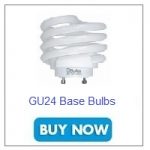 With incandescent light bulbs going the way of the Canadian penny, the time to learn about GU24 lamps is now. These consumer-friendly light bulbs are quickly becoming the new standard for energy efficient lighting, so before jumping into the conservation revolution, here are five important facts about GU24 bulbs to keep in mind:
With incandescent light bulbs going the way of the Canadian penny, the time to learn about GU24 lamps is now. These consumer-friendly light bulbs are quickly becoming the new standard for energy efficient lighting, so before jumping into the conservation revolution, here are five important facts about GU24 bulbs to keep in mind:
1. Not Manufacturer Specific
GU24 lamps were designed to be better than the pin-based bulbs they’re replacing, so naturally replacement was a feature that had to be corrected. Unlike pin-based light bulbs, GU24 lamps can be replaced with bulbs from any manufacturer as long as the fixture has a GU24 socket. This not only makes replacement easier, but this allows you to shop around for the best bulbs without worrying if you’ll be able to easily replace the bulb you have.
2. Ballast: Already Attached and Easily Replaced
Another attempt to correct pin-based compact florescent lamps (CFLs) was to design GU24 lamps with the ballast already attached. The ballast is an electrical device for starting and controlling fluorescent and discharge lamps and is easily replaced.
3. Adaptable to Standard Base Fixtures
Standard base fixtures, or lamps (not to be confused for light bulbs/lamps), are still considered standard because while incandescent bulbs are disappearing, standard base fixtures are not. To make the transition from incandescent to CFL easier, GU24 bulbs can be plugged into an adapter that will fit any standard base fixture.
4. Available in All Color Temperatures
Whether you need the bright lights of Hollywood or the low lighting of a romantic meal, there’s a GU24 lamp for that. They are available in all color temperatures:
- 27000K – Warm white
- 3500K – Soft white
- 4100K – Cool white
- 5000K – Daylight
5. Reduce Energy Consumption and Lighting Costs
There are a few reasons why incandescent light bulbs are disappearing. Aside from the fact that they:
- give off 90% heat and only 10% light
- have a short life span
- use 60-100 watts of power each to light a home
Incandescent light bulbs use up 25-30% more energy than even the federal government is comfortable with. By comparison, GU24 bulbs:
- give off 100% light
- have a lifespan of 10,000 hours or more
- use only 13-27 watts of power each
By using less energy to achieve the the same or even better lighting results, GU24 lamps are a sound option for cost-effective, energy resourceful lighting.

Does GU24 bulbs get hot? I replaced a 60w bulb with another one that is slightly longer. The bulb lies horizontal in a globe ceiling light.
The new bulb touches the glass globe and I am concerned that it will get hot and break the globe. Thank you in advance.
Hi Shirley,
The CFL and LED GU24 bulbs stay cool to the touch. The light is generated using technology that allows the bulbs to remain cool the whole time they’re on.
I purchased LED bulbs that screw into my pre-existing incandescent light fixtures. Will this cause a problem? Will the use of the LED bulb save energy in this situation?
Hi Vic! As long as you’re using either below, or max level wattage set by the manufacturer of your fixture, there shouldn’t be an issue. To make sure, check what incandescent wattage the LEDs you purchased are designed to replace. The LED lights will certainly save energy once installed in comparison to their incandescent equivalents.
The gu 24 bulb that I am using is really touchy meaning every time I turn it on I have to touch to get it to work, why is this? Making sure that I place them in correctly and turning a bit to make them work
I have an outdoor light. Free standing on pole that uses a 120V 13MSL 2700K. It is old. Can I still find a replacement bulb? It comes on at night and turns off in daylight.
Hi, I am a EE and am unhappy with the cost and availability of GU24 A19 bulbs required for our expensive Top Tier ceiling fans installed in 2016 with their 4 light kits. I am considering replacing the four GU24 bases with E26 bases and use standard 7 watt to 12 watt non-dimming bulbs. Alternatively, I would consider a high quality GU24>E26 adapter if I could find one that was UL approved and designed with a high enough temperature rating and durability.
Lighting manufacturer tech support was unwilling to discuss options with me and only wanted to defend their use of GU24 which they incidentally changed to E26 in 2017.
Suggestions are welcome. Thank you.